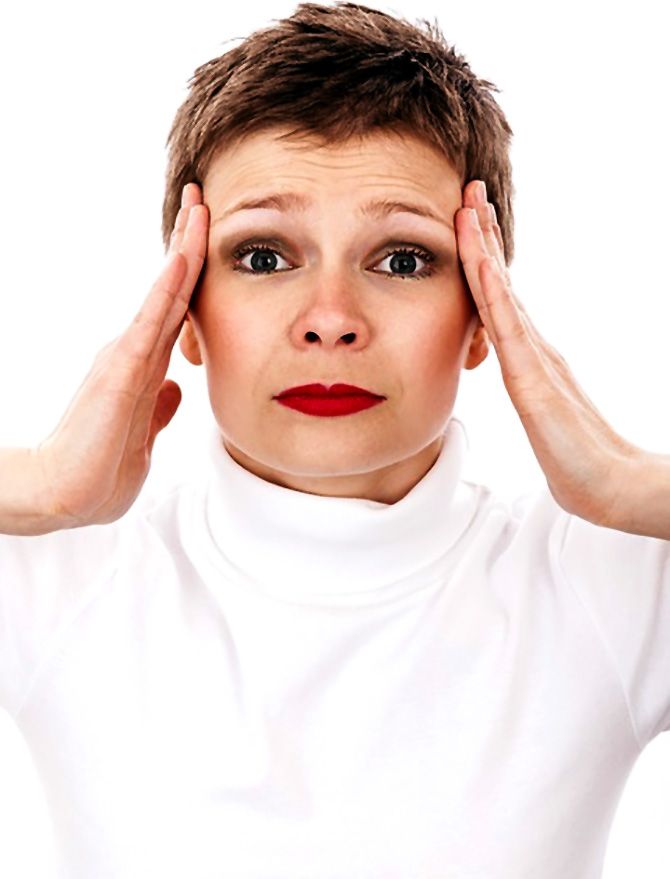 | « Back to article | Print this article |
Anxiety, depression, hormonal changes are just some of the reasons says neurologist Dr Pruthviraj Dabarase.

Photograph: Kind courtesy Pixabay.com
What is migraine?
Migraine is a medical condition manifesting as intense throbbing unilateral or bilateral headache accompanied by one or more symptoms like sensitivity to light, sound or odors, nausea, vomiting or vertigo.
Migraine with aura is accompanied by transient neurological dysfunction, mostly visual deficit, but may involve sensory dysfunction or weakness involving a part of body.
Anxiety and depression are also significantly more common in people with migraine than in healthy individuals.
In Indian set up, lot of nonspecific symptoms like like acidity, neck pain, hemicorporial pain are common.
Migraine has an estimated global prevalence of around 15 per cent.
Women are affected three times as many as men, most likely because of hormonal behaviour.
It often starts at puberty and mostly affects those aged between 35 and 45 years, the age group of women in whom prevalence of migraine can be as high as 35 per cent.
Prevalence of migraine amongst pre-pubertal children is about 4 per cent with equal prevalence amongst boys and girls.
The symptoms in children are cyclical vomiting, pain in abdomen or episodic loose motions with or without headache.
As children grow older, symptoms of migraine become more like adult and female predominance developed. Women experience migraine differently than men.
Episodic pain is reported (often for a longer duration) and chronic pain more frequently than men.
Estrogen levels are one of the main reasons why more severe and more frequent migraine attacks happen amongst women.
Pathophysiology
Migraine pathophysiology involves inherited alteration of brain excitability, intracranial arterial dilatation, recurrent activation and sensitisation of the neurovascular pathways, and consequential structural and functional changes in susceptible individuals.
Mechanism of female predominance of migraine is not clear and not fully accounted for by sex hormones.
In some women, migraine aggravates 1-2 days before and 2-3 days after the onset of bleeding of their menses.
One established theory is sex hormone, estrogen withdrawn as mentioned, just before bleeding in regular menstrual cycles, pill free period when on oral contraceptive pills, after delivery and peri menopausal period when hormonal levels fluctuate.
Why some women are prone for such changes and others are not is unclear.
Estrogen may also be involved in migraine pathophysiology by affecting the vasculature through stimulation of nitric oxide (NO) release.
Other pathogenic mechanisms implicated are prostaglandins and other neuro chemicals like serotonin.
Long term effect of migraine on body
For long time migraine is termed as benign disease without any long term deleterious effects on brain or body. But of late it has been described as a strong Vascular risk factor in women.
MRI Brain during and between attacks show some changes which are nonspecific and reversible.
Nevertheless, migraine is bad disease which takes toll on quality of life and steals a lot of productive hours, and is easily amenable to treatment.
Treatment
Treatment of migraine can be broadly divided into three arms. Each is equally important and has individual attribute to the treatment.
These are lifestyle changes for which there are two types of treatment -- Acute and Preventive.
Lifestyle changes are common for all the people and can be easily incorporated into life.
Plenty of oral fluids, around 2.5 to 3.0L per day, regular (timely) meals (breakfast, lunch, evening snack and dinner), regular and adequate sleeping hours (No late nights, 7 to 8 hr at night) and daytime nap considering bonus.
Regular modest exercise, 45 minutes brisk walk a day, 5 days a week.
Meditation routines like yoga, pranayam may also help for relation and reduce stress level.
Use dark, full field sunglasses with UV400 and polarised protection.
Food products known to trigger migraine need to be identified individually and avoided.
Usual culprits are red wine, hard cheese, dark chocolates, monosodium glutamate, foods containing aginomoto, tyramine etc.
Most Indians also complain about migraine after a head bath.
Acute treatment: These medicines are taken on as and when basis.
To be efficacious, they need to be taken earliest after the onset of headache and can be repeated after some time.
If the frequency of headache is low, these are the one only medicines prescribed along with lifestyle changes.
Preventive treatment: When headache frequency or duration is high then these medicines are prescribed.
These medicines typically take 2-3 weeks for their onset of action and one or more drugs may be combined.
These drugs need to be taken strictly under supervision of the doctor.
In summary, migraine is common disease, more so in women. It takes toll on productive hours but with few lifestyle changes and medicines it is easily treatable.

The author Dr Pruthviraj Dabarase is consultant neurologist at Jaslok Hospital and Research Centre.